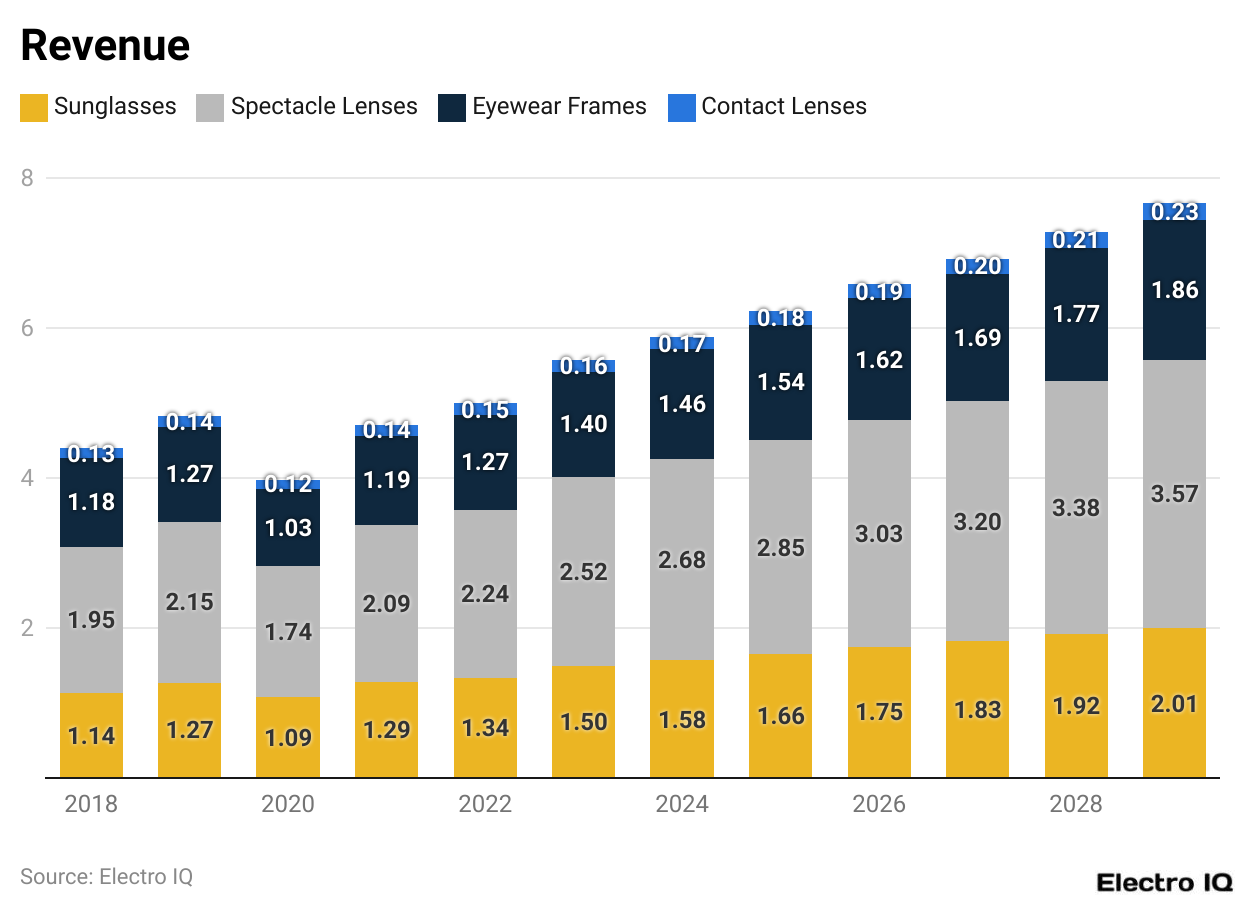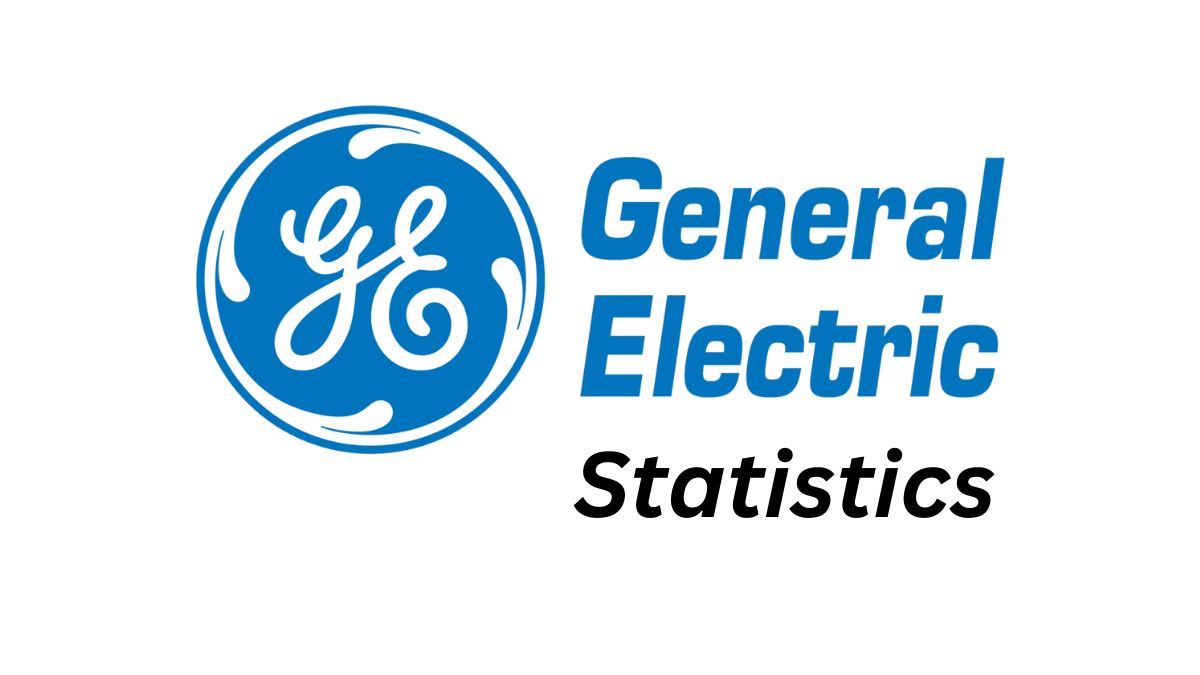Eyewear Statistics By Revenue, Market, Usage, And Brands
Updated · Sep 10, 2024

Table of Contents
- Introduction
- Editor’s Choice
- Revenue Of Eyewear Market By Product Type In The USA
- Vision Impairment Causes
- Global Eyewear Market
- Comparative Analysis Of The Eyewear Market
- Eyewear Usage Among Different Age Groups
- Eyewear Preference
- Online Vs. Offline Eyewear Purchases
- Eyewear Online Brands
- Online Shopping Frequency Among Eyewear Brands
- Eyewear Sales Worldwide
- Eyewear Industry Overview
- Conclusion
Introduction
Eyewear Statistics: The eyewear industry has become one of the most prominent businesses worldwide. It offers a wide variety of products and services to fulfill the needs of prospective clients. Since its introduction, advancements have led to increased awareness in the market.
It would be interesting to review the eyewear statistics and garner essential information about the growth of this industry as a whole. For the most part, studying quantitative and qualitative data sources would be necessary. The information provided below will play a significant role in learning about the importance of the eyewear industry.
Editor’s Choice
- Asia’s eyewear market per capita revenue is expected to be USD 9.33 million by 2024.
- Prescription glasses hold a 60% market share, generating USD 102 billion in 2023.
- Contact lenses accounted for USD 28 billion, representing 17% of the market in 2023.
- Africa’s spectacle lens market volume is estimated at USD 2.65 billion by 2024.
- Eyewear statistics reveal that the global eyewear market hit USD 170 billion in 2023.
- Eyewear sales in the Americas are expected to reach USD 49.04 billion by 2024.
- Australia’s eyewear market volume is expected to reach 80.6 million pieces by 2029.
- Asia’s eyewear market per capita revenue is expected to be USD 9.33 million by 2024.
Revenue Of Eyewear Market By Product Type In The USA

(Reference: Statista.com)
- According to eyewear statistics, the revenue of the eyewear market has increased substantially over the past few years.
- In 2023, the spectacle lenses showcased revenue of $11.59 billion, followed by eyewear frames with $8.5 billion, contact lenses with $4.96 billion, and sunglasses with $5.04 billion.
- It is predicted that spectacle lenses will be worth $14.31 billion by the end of 2027, followed by eyewear frames at $10.39 billion, contact lenses at $6.49 billion and sunglasses at $5.57 billion.
Vision Impairment Causes

(Reference: media.market.us)
- The eyewear statistics show that the prevalence of vision impairment can be categorized into Cataracts, Diabetic Retinopathy, Presbyopia, Glaucoma, Total Vision Impairment, Refractive Error, and Age-Related Macular Degeneration (AMD).
- Presbyopia is the most common vision impairment, with 826 million people affected, cataracts with 94 million following it; Refractive Error with 88.4 million; Age-Related Macular Degeneration (AMD) with 80 million; Glaucoma with 77 million; Diabetic Retinopathy with 39 million, Total Vision Impairment with 1 million affected individuals.
Global Eyewear Market

(Source: media.market.us)
- The eyewear statistics showcase that the global eyewear market is growing significantly at a substantial pace.
- In 2023, the global eyewear market was $134.1 billion.
- By the end of 2033, the global eyewear market is predicted to reach $261.2 billion.
- Between the period (2023 -2033), the global eyewear market will experience a CAGR of 6.9%.
Comparative Analysis Of The Eyewear Market

(Reference: media.market.us)
- The eyewear statistics showcase that the eye market can be categorized into specialty eyewear, safety glasses, contact lenses, sunglasses, and prescription glasses.
- Prescription glasses have the highest market share, with 42%, and annual sales reach $15 billion.
- It is followed by sunglasses with a 30% market share and $11 billion annual sales.
- Finally, there are contact lenses, safety glasses, and specialty eyewear, which have a market share and revenue of 20% with $8 billion in sales, a 5% share with $2 billion in sales, and a 3% market share with $1 billion in sales.
Eyewear Usage Among Different Age Groups

(Reference: media.market.us)
- The eyewear statistics categorize the market into the following categories: seniors, middle-aged, adults, and children.
- Seniors use the highest percentage of eyewear glasses, 65%, followed by Middle-Aged people, 60%, Adults, 30%, and Children, 15%.
Eyewear Preference

(Reference: media.market.us)
- The eyewear statistics reveal that 58% of women prefer eyewear.
- In comparison, 42% of the total respondents were men who prefer eyewear.
Online Vs. Offline Eyewear Purchases

(Source: consumeredge.com)
- Based on the eyewear statistics, one can infer that monthly spending on online vs. offline shopping varies.
- April has shown the lowest level for eyewear purchases in offline mode, with almost 30%.
- In contrast, April had the highest offline mode purchase, with 80% of respondents preferring eyewear purchases.
Eyewear Online Brands

(Source: consumeredge.com)
- Based on the eyewear statistics, one can infer that the age group 25-34 has the highest percentage of online purchases.
- Almost 60% of online purchases from 25-34 prefer purchasing from glass.com.
- The age group of (35-44) has 2nd highest percentage of online purchases among the top online eyewear brands. It is followed by groups of 45-54, 55-64, and 18-24/
- The group [ pf 65+ has the lowest proportion of online shoppers on a comparative basis.
Online Shopping Frequency Among Eyewear Brands

(Source: consumeredge.com)
- The eyewear statistics show that the five major brands from which eyewear consumption occurs among different businesses are eyebuydirect.com, glasses.com, glassesusa.com, Warby Parker, and Zenni Optical.
- com has a maximum number of singular transactions of around 60%.
- Glasses USA has good recurring customers, with almost 50% of all transactions done.
- Similarly, glassesusa.com has the highest number of online eyewear transactions, around 10%.
Eyewear Sales Worldwide

(Reference: Statista.com)
- The eyewear statistics show that by the end of 2024, the eyewear market is expected to reach $146 billion in revenue globally.
- The annual revenue growth rate of the eyewear market is expected to be 3.39% from 2024 to 2029.
- The largest section of the worldwide lens brand is the spectacle lenses, which generates $60.74 billion in overall revenue.
- By the end of 2029, the overall market volume of spectacle lenses is expected to be 10.2 billion.
- Globally the United States generates the highest revenue, with a projected revenue of $35.2 million expected by the end of 2024.
Eyewear Sales Asia

(Reference: Statista.com)
- The eyewear statistics show that Asia’s per capita revenue is estimated to be $9.33 million by the end of 2024.
- Holistically, the overall volume of the eyewear market is expected to reach 4.2 billion by the end of 2029, showing a growth of 0.9% in 2025.
- The eyewear market of Japan is based on the demand involving high quality and innovative design-based projects that cater to the requirements of its aging population.
Eyewear Sales Europe

(Reference: Statista.com)
- Eyewear statistics showcase France as a region driven by the requirements for high-end products.
- Nonluxury products in Europe make up 84% of total sales in the eyewear market.
- The volume of growth in this region is expected to be 0.8%.
Eyewear Sales Americas

(Reference: Statista.com)
- Eyewear statistics reveal that the market’s revenue is expected to reach $49.04 billion by the end of 2024.
- The cagr between the period (2024 – 2029) is expected to be 3.32% annually.
- By the end of 2029, the volume of eyewear is expected to increase to 2.4 billion pieces.
- The United States is focusing on eco-friendly and sustainable eyewear.
- Nonluxury eyewear products are predicted to account for 78% of the eyewear market’s sales by the end of 2024.
- Spectacle Lesnes is the largest market segment that is expected to account for $19.63 billion by the end of 2024.
Eyewear Sales Africas

(Reference: Statista.com)
- Eyewear statistics reveal that in Nigeria, there is a growing demand for fashionable eyewear, mainly among the younger population.
- When it comes to volume per person, the eyewear market is expected to be 0.6 pieces by the end of 2024.
- The projected revenue based on revenue per capita for the eyewear market is expected to be $5.10 by the end of 2024.
- In Africa, the largest segment in the eyewear market is spectacle lenses, which account for a market volume of $2.65 billion by the end of 2024.
Eyewear Sales Oceania

(Reference: Statista.com)
- According to eyewear statistics, Australia’s eyewear market focuses on locally made sustainable and eco-friendly products.
- The volume of eyewear products is expected to be 80.6m pieces by the end of 2029.
- The expected growth rate of the eyewear market is expected to be 0.9% by the end of 2025.
- The average volume per person in Australia’s eyewear market is expected to become 1.8 pieces by the end of 2024.
- The largest segment of eyewear products is spectacle lenses, which are expected to have a market volume of $1.31 billion by the end of 2024.
- The revenue of the eyewear market in the Oceania region is expected to be $3.28 billion, with an expected annual growth rate to be 2.99 % between the period 2024 – 2029.
Eyewear Market In India

(Reference: Statista.com)
- By the end of 2024, the eyewear market is expected to reach $5.9 billion.
- In India, there is a growing demand for affordable eyewear with an emphasis on stylish frames and prescription lenses.
- The per-person eyewear market revenue is expected to be $4.09 by the end of 2024.
- 94% of all sales in India account for the nonluxury segment.
- The largest segment of sales in India is spectacle lenses, with a projected market volume of $2.68 billion by the end of 2024.
Eyewear Industry Overview
- In 2023, the global eyewear market experienced significant growth, reaching approximately $170 billion in revenue. This growth was driven by increased consumer awareness of eye health, a rising aging population, and the growing popularity of fashion eyewear. The market is expected to continue its upward trajectory in 2024, with projections indicating that it could surpass $185 billion in revenue by the end of the year. This represents a compound annual growth rate (CAGR) of around 5%, highlighting the steady demand for eyewear products.
- One of the key trends in the eyewear market is the increasing preference for prescription glasses. In 2023, prescription glasses accounted for nearly 60% of the total market share, equating to approximately $102 billion in revenue. This segment is expected to maintain its dominance in 2024, with an estimated market share of around 61% and revenues reaching close to $113 billion. The demand for prescription glasses is largely driven by the rising prevalence of visual impairments and the growing awareness of the importance of regular eye check-ups.
- The sunglasses segment also showed strong performance in 2023, generating around $40 billion in revenue, which accounted for about 23% of the total eyewear market. With the increasing focus on fashion and protection from harmful UV rays, the sunglasses market is expected to grow further in 2024, reaching nearly $45 billion. This growth represents an increase in market share to approximately 24%, reflecting the ongoing consumer interest in stylish and functional eyewear.
- Contact lenses are another significant segment within the eyewear market. In 2023, the global contact lenses market was valued at around $28 billion, representing about 17% of the total eyewear market. This segment is anticipated to grow in 2024, with revenues expected to reach $30 billion, maintaining a similar market share of 16%. The demand for contact lenses is being driven by the convenience they offer and advancements in lens technology that enhance comfort and usability.
- Online sales have become a crucial distribution channel for eyewear products. In 2023, online sales accounted for approximately 20% of the total eyewear market, generating around $34 billion in revenue. This trend is expected to continue in 2024, with online sales projected to contribute $38 billion to the market, representing a 21% share. The convenience of online shopping and the availability of a wide range of products at competitive prices are key factors driving this growth.
Conclusion
The eyewear industry has successfully transitioned itself to become an industry that focuses on providing eyesight correction products to fashion pieces. As the global market of eyewear reached $170 billion, the demand for prescription glasses, contact lenses, and sunglasses is expected to reach and meet the consumer’s demand adequately.
The eyewear statistics show that the trends based around the eyewear market direct to the fact that the overall eyewear market can reach $185 billion globally by the end of 2024. As the industry grows consistently, it is expected to remain a critical player in both the healthcare and fashion industries.
Sources
FAQ.
The global eyewear market reached approximately $170 billion in 2023.
Prescription glasses dominate, accounting for nearly 60% of the market share.
Online sales contribute around 20% to the total market, with continued growth expected.
The market is projected to grow at a CAGR of around 5% through 2024.
Convenience and advancements in lens technology are key drivers for contact lenses.

Pramod Pawar brings over a decade of SEO expertise to his role as the co-founder of 11Press and Prudour Market Research firm. A B.E. IT graduate from Shivaji University, Pramod has honed his skills in analyzing and writing about statistics pertinent to technology and science. His deep understanding of digital strategies enhances the impactful insights he provides through his work. Outside of his professional endeavors, Pramod enjoys playing cricket and delving into books across various genres, enriching his knowledge and staying inspired. His diverse experiences and interests fuel his innovative approach to statistical research and content creation.









